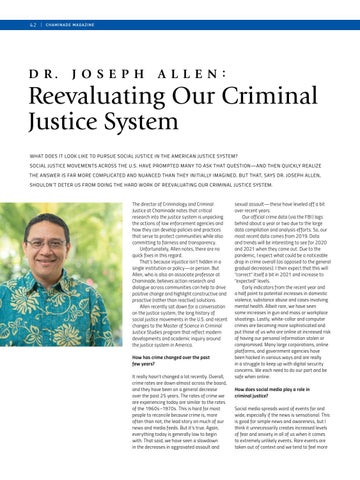42 |
C H A M IN A DE MAGAZI NE
D R.
J OSEPH
ALLEN :
Reevaluating Our Criminal Justice System WHAT DOES IT LOOK LIKE TO PURSUE SOCIAL JUSTICE IN THE AMERICAN JUSTICE SYSTEM? SOCIAL JUSTICE MOVEMENTS ACROSS THE U.S. HAVE PROMPTED MANY TO ASK THAT QUESTION—AND THEN QUICKLY REALIZE THE ANSWER IS FAR MORE COMPLICATED AND NUANCED THAN THEY INITIALLY IMAGINED. BUT THAT, SAYS DR. JOSEPH ALLEN, SHOULDN’T DETER US FROM DOING THE HARD WORK OF REEVALUATING OUR CRIMINAL JUSTICE SYSTEM.
The director of Criminology and Criminal Justice at Chaminade notes that critical research into the justice system is unpacking the actions of law enforcement agencies and how they can develop policies and practices that serve to protect communities while also committing to fairness and transparency. Unfortunately, Allen notes, there are no quick fixes in this regard. That’s because injustice isn’t hidden in a single institution or policy—or person. But Allen, who is also an associate professor at Chaminade, believes action research and dialogue across communities can help to drive positive change and highlight constructive and proactive (rather than reactive) solutions. Allen recently sat down for a conversation on the justice system, the long history of social justice movements in the U.S. and recent changes to the Master of Science in Criminal Justice Studies program that reflect modern developments and academic inquiry around the justice system in America. How has crime changed over the past few years? It really hasn’t changed a lot recently. Overall, crime rates are down almost across the board, and they have been on a general decrease over the past 25 years. The rates of crime we are experiencing today are similar to the rates of the 1960s–1970s. This is hard for most people to reconcile because crime is, more often than not, the lead story on much of our news and media feeds. But it’s true. Again, everything today is generally low to begin with. That said, we have seen a slowdown in the decreases in aggravated assault and
sexual assault — t hese have leveled off a bit over recent years. Our official crime data ( via the FBI ) lags behind about a year or two due to the large data compilation and analysis efforts. So, our most recent data comes from 2019. Data and trends will be interesting to see for 2020 and 2021 when they come out. Due to the pandemic, I expect what could be a noticeable drop in crime overall ( as opposed to the general gradual decreases ). I then expect that this will “correct” itself a bit in 2021 and increase to “expected” levels. Early indicators from the recent year and a half point to potential increases in domestic violence, substance abuse and cases involving mental health. Albeit rare, we have seen some increases in gun and mass or workplace shootings. Lastly, white-collar and computer crimes are becoming more sophisticated and put those of us who are online at increased risk of having our personal information stolen or compromised. Many large corporations, online platforms, and government agencies have been hacked in various ways and are really in a struggle to keep up with digital security concerns. We each need to do our part and be safe when online. How does social media play a role in criminal justice? Social media spreads word of events far and wide, especially if the news is sensational. This is good for simple news and awareness, but I think it unnecessarily creates increased levels of fear and anxiety in all of us when it comes to extremely unlikely events. Rare events are taken out of context and we tend to feel more





























